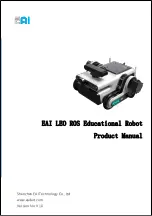
RealMan (Beijing) Intelligent Technology Co., Ltd.
12
➢
A comprehensive risk assessment of a complete robotic system.
➢
To confirm the design and installation of the entire system is accurate.
➢
To provide training to users and staff.
➢
To create operation specification of a complete system, and clear description
of use process.
➢
To establish appropriate safety measures.
➢
To use appropriate methods to eliminate hazards or minimize all hazards to
acceptable levels at the time of final installation.
1.5 Hazard Identification
The risk assessment should take into account all potential contacts between the operator
and the robot and foreseeable maloperations during normal use. The neck, face and
head of the operator should not be exposed to avoid touching. The use of a robot without
the use of peripheral safety guards requires first a risk assessment to determine whether
the associated hazards pose an unacceptable risk, including but not limited to:
➢
The use of sharp actuator or tool connectors which may be dangerous.
➢
Handling toxic or other hazardous substances.
➢
The operator's fingers being caught by the robot base or joint.
➢
The operator being hit by robots.
➢
The fastness of robot and tool connected to its end.
➢
Impact between the robot payload and the firm surface.
The integrator must measure such hazards and their associated risk levels through a risk
assessment and identify and perform appropriate measures to reduce the risk to an
acceptable level. Be aware that there may be other significant hazards associated with
certain robotic devices.
By combining the inherent safety design measures applied by the RM75-B robot with
the safety specifications or risk assessments implemented by the integrator and user,
the risks associated with collaborative robot operation are minimized to a reasonable










































